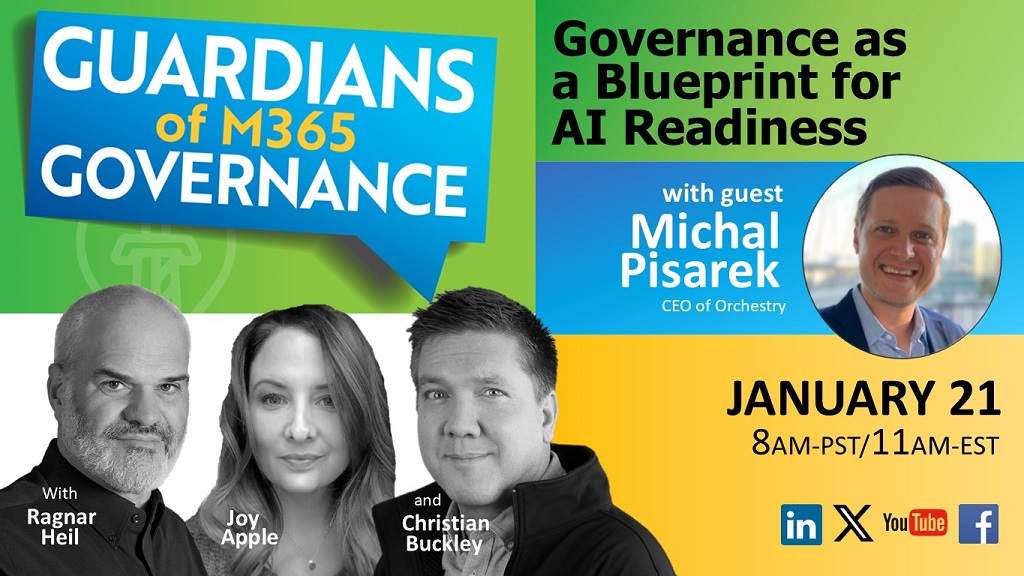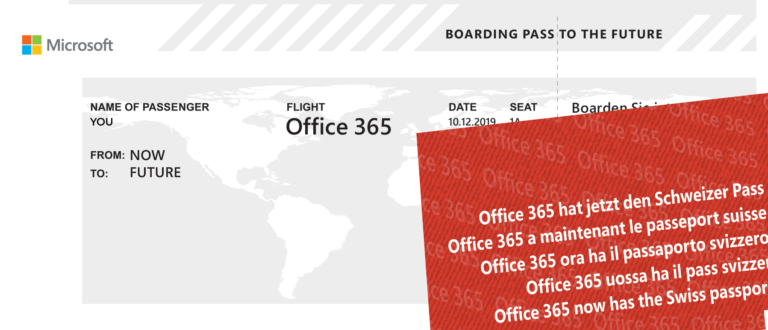Microsoft 365 Governance as a Blueprint for AI Readiness
As we enter 2025, Microsoft 365 governance is undergoing a significant transformation driven by the rapid adoption of AI technologies like Copilot and AI agents. During a recent episode of “Guardians of M365 Governance,” industry experts discussed how traditional governance approaches are evolving to meet new challenges and opportunities in the AI-powered workplace
The New Governance Imperative
Michael Pisarek, CEO of Orchestry, highlighted three key governance challenges organizations face as they prepare for AI adoption in our video with MVP Christian Buckley, MVP Joy Apple and me:
- Content Quality and Management The fundamental issue is that “if you’ve got a bunch of crap content, Copilot is just going to give you back a bunch of crap.” Organizations struggle with:
- Massive amounts of outdated content
- Multiple versions of documents scattered across sites
- Limited resources to manually clean up and organize content
- Difficulty identifying relevant vs. irrelevant information
- Security and Permissions SharePoint’s flexible sharing capabilities can create complex permission scenarios:
- Broken inheritance chains
- Excessive direct permissions
- Untracked sharing links
- Guest access management
- Multiple permission paths (direct, groups, Azure AD)
- User Adoption and ROI With Copilot licenses at $30/user/month, organizations need to:
- Demonstrate clear business value
- Track usage patterns
- Measure productivity gains
- Justify the investment
The Rise of AI Agents
A significant development in 2025 is the emergence of AI agents within Microsoft 365. These agents can be:
- Created within SharePoint sites
- Scoped to specific content sets
- Developed by third parties
- Deployed through marketplaces
This brings new governance considerations:
- Who can create and deploy agents?
- How to control agent access and permissions?
- Managing consumption-based costs
- Monitoring agent activities and impact
The Shift to Pay-as-you-go Models
Ragnar Heil, Microsoft MVP, emphasized how licensing models are evolving:
- Moving from fixed per-user pricing to consumption-based models
- Need for cost control mechanisms
- Importance of usage monitoring
- Risk of unexpected costs from widespread agent adoption
Automated Governance Solutions
The experts agreed that successful governance requires automation. Key aspects include:
Lifecycle Management
- Automatic archival of inactive content
- Regular permission reviews
- Version control
- Guest access cleanup
Owner Empowerment
- Simplified dashboard views
- Activity feeds
- Action recommendations
- Regular review prompts
Intelligent Automation
- AI-powered cleanup recommendations
- Automated policy enforcement
- Pattern detection
- Anomaly alerts
Best Practices for Modern Governance
- Empower Content Owners
- Provide clear visibility into their digital workspace
- Enable easy permission management
- Automate routine maintenance tasks
- Regular review prompts
- Implement Strong Provisioning
- Standardized templates
- Built-in lifecycle policies
- Automated security controls
- Clear ownership assignment
- Monitor and Adapt
- Track usage patterns
- Measure adoption metrics
- Analyze cost implications
- Adjust policies as needed
Looking Ahead
The future of Microsoft 365 governance will likely include:
AI-Powered Automation
- Intelligent agents managing routine tasks
- Automated policy enforcement
- Pattern-based recommendations
- Natural language interfaces
Enhanced User Experiences
- Voice-based interactions
- Simplified management interfaces
- Contextual recommendations
- Proactive notifications
Cost Management
- Granular usage tracking
- Automated optimization
- Predictive analytics
- ROI measurement
Conclusion
As organizations embrace AI technologies within Microsoft 365, governance becomes more critical than ever. Success requires a balanced approach that combines:
- Strong foundational policies
- Automated enforcement
- User empowerment
- Continuous monitoring and adaptation
The key is making governance invisible to end users while ensuring organizational compliance and security. As Michael Pisarek noted, “It has to provide information that’s both useful and actionable.” By leveraging new tools and approaches, organizations can create a governance framework that enables innovation while maintaining control.
The future of Microsoft 365 governance is evolving rapidly, and organizations that adapt their approaches to incorporate AI capabilities while maintaining strong controls will be best positioned for success in this new era
Contact us at HanseVision about your Entra ID, Copilot, Microsoft Teams and Governance questions
You can also listen to this Episode as a Podcast in your favorite Player and Podcatcher – or just jump to Spotify here:







This shift in Microsoft 365 governance is a fascinating and necessary evolution as AI technologies like Copilot and AI agents become integral to the workplace. The introduction of AI agents and the move to consumption-based pricing models will certainly challenge organizations to rethink their governance strategies.
It’s exciting to see how automation, like lifecycle management and intelligent AI-powered solutions, can help alleviate the burden of manual tasks while ensuring security and efficiency. At the same time, empowering content owners with easy-to-use tools and clear dashboards is crucial for maintaining control.
As AI-driven tools continue to enhance user experiences, how do you think organizations can best balance security and cost control while maximizing the productivity and value these AI innovations offer?